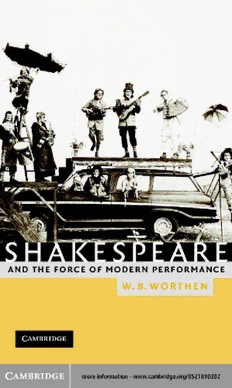
Shakespeare and the Force of Modern Performance PDF
Preview Shakespeare and the Force of Modern Performance
This page intentionally left blank SHAKESPEARE AND THE FORCE OF MODERN PERFORMANCE ShakespeareandtheForceofModernPerformanceasksacentral theoretical question in the study of drama: what is the rela- tionship between the dramatic text and the meanings of per- formance?Developingthenotionof“performativity”explored byJ.L.Austin,JudithButler,andothers,Worthenarguesthat the text cannot govern the force of its performance. Instead the text becomes significant only as embodied in the chang- ingconventionsofitsperformance.Worthenexploresthisun- derstandingofdramaticperformativitybyinterrogatingseveral contemporarysitesofShakespeareproduction.Heanalyzeshow Shakespeareisrecreatedinhistoricalperformance,exemplified by the Globe Theatre on Bankside; by international and in- tercultural performance; by film; and by the appearance of Shakespeareontheinternet.Thebookincludesdetaileddiscus- sionsofrecentfilmsandstageproductions,andsetsShakespeare performancealongsideotherworksofcontemporarydramaand theatre. w. b. worthen isProfessorandChairoftheDepartmentof Theater,Dance,andPerformanceStudiesattheUniversityof California,Berkeley.HeistheauthorofTheIdeaoftheActor: DramaandtheEthicsofPerformance(1984),ModernDramaand theRhetoricofTheater (1992),ShakespeareandtheAuthorityof Performance(Cambridge,1997),andofawiderangeofarticles ondramaandperformanceinmajorjournals. SHAKESPEARE AND THE FORCE OF MODERN PERFORMANCE W. B. WORTHEN UniversityofCalifornia,Berkeley The Pitt Building, Trumpington Street, Cambridge, United Kingdom The Edinburgh Building, Cambridge CB2 2RU, UK 40 West 20th Street, New York, NY 10011-4211, USA 477 Williamstown Road, Port Melbourne, VIC 3207, Australia Ruiz de Alarcón 13, 28014 Madrid, Spain Dock House, The Waterfront, Cape Town 8001, South Africa http://www.cambridge.org ©W. B. Worthen 2004 First published in printed format 2003 ISBN 0-511-02970-5 eBook (Adobe Reader) ISBN 0-521-81030-2 hardback ISBN 0-521-00800-X paperback Contents Acknowledgments pagevi Introduction:dramaticperformativityandtheforce ofperformance 1 1 Performinghistory 28 2 Globeperformativity 79 3 Shakespeareangeographies 117 4 Cyber-Shakespeare 169 Notes 216 Workscited 238 Index 262 v Acknowledgments Writingthisbook,Ihavebeenblessedtohavesuperbreaders,whose ownworkhasoftenbeenachasteningexampleofhowtodoitright: JoelAltman,MichaelBristol,UnaChaudhuri,PeteDonaldson,Tony Dawson,BarbaraHodgdon,PeterHolland,RomanaHuk,Shannon Jackson, Caren Kaplan, Ric Knowles, Jeffrey Masten, Gail Kern Paster,PeggyPhelan,CarolRutter,EricSmoodin,JoanneTompkins, Wendy Wall, Robert Weimann, and Frank Whigham have read, re- sponded to, or discussed various parts of this project with me, and manyhaveprovidedextraordinaryhospitalityaswell.Ihavedelivered nearlyallofthisbookatannualsessionsoftheInternationalCentre for Advanced Theatre Studies, sponsored by Pirkko Koski and the University of Helsinki, and I should particularly like to thank the faculty–PirkkoKoski,BruceMcConachie,JanelleReinelt,Freddie Rokem,andSteveWilmer–andourstudentstherefortheirkeencrit- icismandpatientforbearancewithwritingusuallyfarremovedfrom their own interests. I should also like to thank Barbara Hodgdon, Dennis Kennedy, David Kastan, and Joanne Tompkins for mak- ing unpublished writing available to me, and Peter Lichtenfels, Lynette C. Hunter, and Christopher Peak for answering a nearly endless stream of niggling questions about their production (and edition)ofRomeoandJuliet,andfortheprivilegeofdiscussingtheir work with them. I am grateful to Verna Foster (Loyola University), Margaret Knapp (Arizona State University), Michal Kobialka (University of Minnesota), Linda Morris (University of California, Davis), Celeste di Nucci (University of Pennsylvania), and Robert Weimann(UniversityofCalifornia,Irvine)forinvitingmetospeak about my work; and to audiences at the American Society for TheatreResearch,theModernLanguageAssociation,theShakespeare vi Acknowledgments vii AssociationofAmerica,andtheShakespeareInstitutefortheiratten- tionandcomments.Myspecificindebtednesstoseveralextraordinary studentsisexpressedbelow,butIshouldliketoexpressmygratitude to Elizabeth Deitchman, Kathleen Gough, Katie Kalpin, Johanna Schmitz, and Don Weingust for what I have had the privilege of learning from them; I should also like to thank Johanna Schmitz, SharonPressburgBraden,TateDavis,andJohnRaePerigoeformuch- needed research assistance. William Rachelson generously answered myrudimentaryquestionsaboutelectronictechnology,andIamsure IgotbetterthanIgavefromsharingworkonelectronictechnologies with Jillana Enteen. Cle´lia Francesca Donovan provided indispens- able translations of work on Grupo Galpa˜o, and I am thankful to Grupo Galpa˜o for providing me with materials documenting their extraordinarywork.Ihavealsogreatlybenefitedfromtheadviceand supportofthestaffofCambridgeUniversityPress,particularlySarah StantonandJackieWarren.ShannonSteendivertedtimeawayfrom more important work to read and discuss this project with me; in this,asinmanyotherthings,Iamimmeasurablythericher. Iamgratefultothefollowingforpermissiontousepreviouslypub- lished material here in much-revised form. I first worked out some concernswiththe“performative”in“Drama,Performativity,andPer- formance,” as well as some initial thoughts on William Shakespeare’s Romeo + Juliet that appear here in chapter 3, in PMLA 113 (1998): 1093–107. Portions of the introduction and first chapter originally appearedas“ShakespeareanPerformativity,”inShakespeareandMod- ern Theatre: The Performance of Modernity, ed. Michael Bristol and KathleenMcLuskie,withChristopherHolmes(London:Routledge, 2001):117–41;anearlierversionofmydiscussionoftheGlobeThe- atreinchapter2appearedas“ReconstructingtheGlobe,Constructing Ourselves,” Shakespeare Survey 52 (1999): 33–45; and parts of chap- ter 4 were published as “Hyper-Shakespeare,” Performance Research 7.1 (2002): 7–21. Finally, I would like to thank the Committee on Research and the University of California, Davis, and the Commit- teeonResearchandtheCollegeofLettersandSciences,Universityof California,Berkeley,forseveralresearchgrants,andfortheHuman- itiesResearchFellowshipthatenabledmetocompletetheproject.
